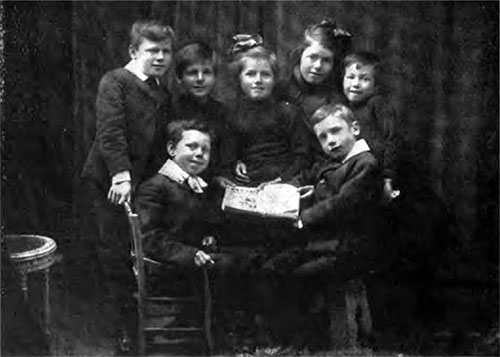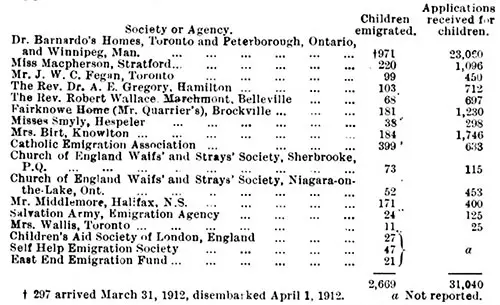Canada's Child Immigrants - 1913

Child Emigrants Sent to Canada During the Summer of 1912 by the Salvation Army. Canada Today, 1913. GGA Image ID # 14c6e93b40
A Vast Field, a Wide Demand, and an Inadequate Supply.
The extensive field which Canada offers for child immigrants is being increasingly recognized in the British Isles, both by emigration authorities and societies, and also private individuals.
The vastness of this field, and the satisfactory result of the work of the various agencies operating within it, are emphasized in the report for the year ending March 31, 1912, prepared by Mr. G. Bogue Smart, Chief Inspector of British Immigrant Children and Receiving Homes, and presented to the Superintendent of Immigration at Ottawa.
The generally satisfactory outcome of the work Mr. Smart credits to the following factors:
- (a) Probationary pre-emigration training.
- (b) Careful selection, and
- (c) The maintaining in Canada of a continuous supervision by those who must be responsible for the children until they reach at least the age of eighteen.
The average age of the children on their arrival in Canada is between twelve and thirteen.
A Desirable Type
The type of the British juvenile immigrant, Mr. Smart notes, has been desirable from the point of view of Canada's requirements. The children were almost immediately after their arrival at the Receiving and Distributing Homes dispatched to foster homes and to situations arranged for the most part in advance of their emigration.
These centers of reception and distribution are located in the Provinces of Ontario, Quebec, Nova Scotia, and Manitoba, and number eighteen in all. The various Provinces receive, according to the openings offered, a fair number in the distribution of these youthful settlers.
"The lofty aim and principles of the founders of this admirable movement,'' Mr. Smart remarks, "have been respected, and it affords me pleasure to report that the children have been, with few exceptions, desirably placed, and in houses and situations wherein they may reasonably expect to develop habits of industry and become good, useful citizens of the Dominion."
The children visited during the year were found to be in the enjoyment of good health and sound physique, and these most satisfactory conditions, Mr. Smart suggests, are no doubt the outcome largely of the care and regard paid by the authorities to the hygienic surroundings of the children in the preparatory homes and schools in the Old Country.
Of 1,744 children inspected and reported upon during the year under review, 1,536 were found to be making very good progress, and giving entire satisfaction to their employers, and 179 were considered good or fair. Only 29 of this large total were pronounced unsatisfactory.
"The British juvenile immigrant," points out Mr. Smart, " is like other boys, good, bad, and indifferent in disposition, and it depends largely on how he is treated whether or not he will do well."
As regards the character and behavior of the Old Country boy in Canada, the reports speak well for their early training, for out of the total of 1,744 the number found to be very good was 1,557, good or fair 158, and unsatisfactory 29.
The children visited, with comparatively few exceptions, were found well housed, properly clad, and reasonably remunerated for their labor. " An equally gratifying result of the year's inspection is that such a small number were described as 'undesirable.' It is a very uncommon occurrence to find a juvenile immigrant in the ' arms of the law.' "
Supply and Demand
There has been a constant call for the services of these children, and almost exclusively from farmers, although many good openings in the towns and cities heave been filled by girls, from 14 to 16 years of age, as house and nurse maids. "The absence of this annual source of supply would be felt acutely by the farming community," declares Mr. Smart.
"The services of these young immigrants on our farms have become, in fact, indispensable. There are many kinds of farm work which a boy can do quite as well as a man."
The accompanying chart sets forth in a striking manner the disparity between supply and demand, and must be accepted as collateral proof of the acceptability of the services of these child immigrants.
Statistics show that an army of about 25,000 children have been brought to Canada within the space of little more than a single decade, and the small proportion of failures already alluded to, Mr. Smart says, applies to all of these.
The following statement shows the number of children emigrated by the principal agencies during the years 1911-12, and the applications received for them : —

Table showing the number of children emigrated by the principal agencies during the years 1911-12, and the applications received for them. Canada Today, 1913. GGA Image ID # 14c70285ef
"A number of one-time British juvenile immigrants, after completing their apprenticeship in Eastern Canada," M r . Smart states, "have joined in the rush to the Western Provinces, where they have taken up Government land, and become successful farmers. Many of the boys at the age of 17 or 18 years also go to Western Canada as harvestors and take advantage of the midsummer excursions. Pleased with the conditions and prospects, they remain in the West. Others have acquired land in the older Provinces in their own right, or become 'tenant farmers,' and in the main are prosperous and contented."
"The Child Immigrant," in Canada Today, 1913, p. 58.
